With the unrest that is happening within the United States at the moment, we hope that you can stay safe out there. Ensure you and those you care for are out of harm's way, protect yourself. No matter which side you may be on, we respect your stance as long you are a decent human being, and we hope you're well. As for those not living in the United States, stay safe from COVID-19 pandemic, and always remember to wear a mask outside your home.
Hi, I'm Asada_FiveFiveSixer from Project 80 dev team, and continuing from the previous article totally not trying to impersonate Forgotten Weapons intro btw we are going to take a closer look to the weapons we feature in Project 80 mod. Of course, we can't necessarily cover all weapons so we are going to focus on the primary small arms during the 1980s of both sides -- United States and Soviet Union. With our advanced weapon system available in the mod, we can have weapons to have a much more diverse and detailed performance. This includes different variety of ammunition, interchangable ammo depending on cartridge, solid differences between types of weapons, SAWs like the M249 and RPK having their own handling characteristics compared to either rifles or GPMGs, realistic weights, practical-based accuracy and spread pattern of weapons, etc.
We plan to make alpha release of Project 80 available to the public somewhere this month, so you want to discover how things actually work instead of being mesmerized, just hang in there...
Now let's get started with...
US Armed Force's Arsenal
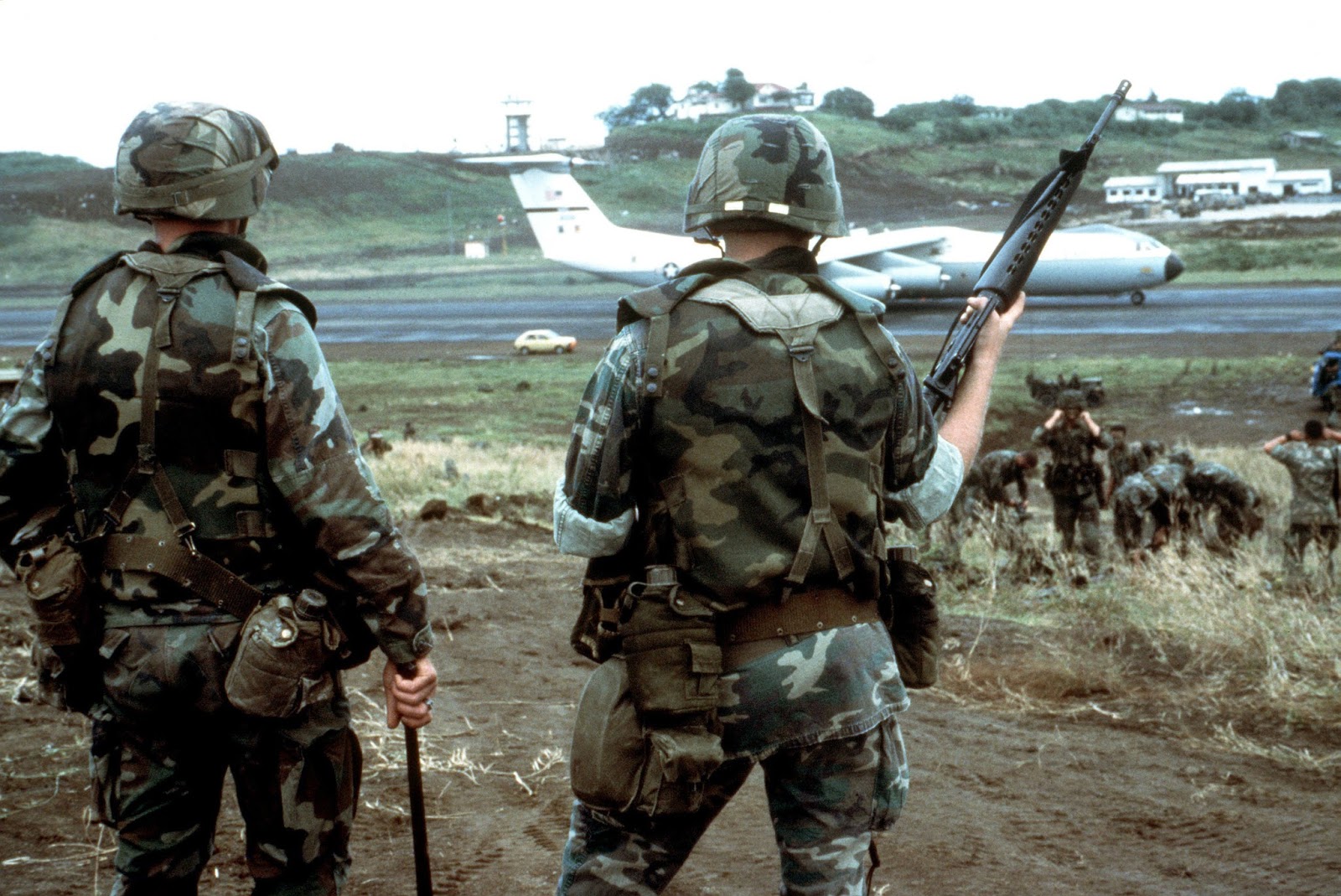
M16A1

The original M16 was a subject to poor performance in Vietnam due to lack of cleaning kits, troops not being instructed on how to maintain them, lack of weapon familiarity, wrong powders on ammunition, bureaucracy nonsense, all attributing to the bad early reputation. A lot of issues were rectified with the A1 version, which had chrome lined chamber, forward assist, along with other improvements and ammunition that used the proper powder. Since then, the M16/AR family rifles had become the staple of modern rifles chambered in small high velocity intermediate cartridges (5.56, 5.45, 5.8). Even after the M16A2 was adopted, the M16A1 continued to see rear echelon use all the way to late 1990s. The M16 family rifles had served the US military reliably until today.
Notes: - The Colt USGI 20-round magazines were supposed to be disposable and had reliability issues especially when loaded to full capacity of 20. It was common practice to load 18 round into the magazine instead to prevent misfeed. While frontline troops had transitioned to 30-rounders by this time period, 20-round magazines were still common within rear echelon troops.
- US Army infantry units engaged in Grenada were primarily armed with M16A1s with 30 round magazines.
- ARs are not unreliable as long you know how to maintain them and don't keep firing like a chimp. Eugene Stoner is not stupid. Fuck this myth
- ARs have much better chance of surviving muds than AKs due to its more sealed design. I'm not bullshitting
M16A2

As accordance to requests primarily coming from the USMC, it was officially adopted as "US Rifle, 5.56mm, M16A2" in 1982. Extensive modifications included new 1:7 twist rifling to stabilize the heavier 62-grain M855 projectile (US version of Belgian SS109 projectile) which provides better penetration and long range performance at the expense of inferior wounding capability especially within shorter distances compared to the Vietnam-era M193. New adjustable rear sight, A2 birdcage flash hider, forward assist, rounded handguard, buttstock with a small compartment, brass deflector for more friendliness to left-handed shooting, and safe-semi-burst selector. The USMC adopted the M16A2 starting from the early 1980s whereas US Army adopted it by mid-late 1980s, which they used it as their primary rifle during the Invasion of Panama up until the early 2000s. The current M16A4 in use primarily by US Marine non-combat personnel is no different than the M16A2 other than having KAC picatinny railed handguards and new stampings on the receivers.
Notes: - M16A2 and following generation rifles (including M4s) were primarily made by both Colt and FN Herstal, and currently FN is the primary producer of US military M16s and M4s.
- WARNING: Do NOT use M855 and other heavier projectiles in the M16A1. The 1:12 rifling twist on the M16A1 is not sufficient to stabilize heavier projectiles, so stick with the M193 for the A1 and do not use any other load unless in emergency. The M193 is safe to fire from the 1:7 rifling twist of M16A2 and following rifles. Yes, this DOES matter in the mod as well, if you use M855 or any other projectile in A1s you will have terrible accuracy. Keep that in mind (irl there were cases of M855 flying 45 degree out of the barrel of A1 as well)
M249

US licensed production variant of the FN Minimi. Replacing the M60 which had been in service, the M249 is a squad automatic weapon that is capable of unleashing a minimum of 700 rounds per minute within either a 100 or 200-round belt (100-round belts did not exist until the 90s or 2000s if I recall). The version used by the US military during this period was the M249E1 variant. First saw action in Invasion of Grenada, the M249 continued to be updated and remained in service within US Army and National Guards today, whereas USMC had largely replaced the M249 with the M27 IAR -- a variant of the HK416.
Notes: - The M249 was originally designated the Squad Automatic Weapon (SAW), but the designation was later dropped in 1994, according to the preface of FM (United States Army Field Manuals) 23-14 "M249 Light Machine Gun In The Automatic Rifle Role". The SAW name is still commonly (though inconsistently) used despite of that.
- Variants of the M249 are sometimes named with EX (X being a number) suffixes; M249E1 (or XM249E1) is associated with the pre-PIP original M249, M249E2 (or XM249E2) is associated with the post-PIP upgraded M249, and M249E3 is associated with the M249 Para. However, there does not appear to be any official use of these designations, and the official designation for all variants remained M249
- The M249/Minimi is capable of using STANAG 5.56 magazines as well, but it is not recommended unless in emergency. The reliability rate of using rifle magazines within the M249 is low and jams are frequent. We'll figure out how to code that in-game if we could
- The FN Minimi and its derivatives are in use widely by forces utilizing 5.56x45 as their service cartridge, and as the primary SAW of NATO forces worldwide.
M60

The M60 GPMG was introduced in 1957 to replace the M1918A2 BAR and M1919A6 .30 caliber machine gun, providing a large amount of suppression fire capability thanks to its belt fed ammunition system. It is loosely based on the German MG42, albeit with a greatly reduced rate of fire. US military personnel have nicknamed the M60 "The Pig" due to its size and weight. Chambered for 7.62x51mm cartridge with disintegrating belts. Replaced by the M240 within mid/late 1980s in infantry usage.
M240
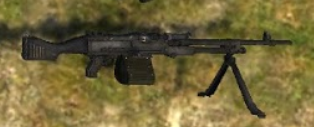
US licensed production variant of the FN MAG, it entered service initially as tank coaxial machine guns to replace aging M73 and M219 machine guns. Thus you can expect all M60 Pattons by the 1980s to be equipped with M240 coaxial. It then continued to replace the M60 as the primary GPMG of the US armed force as a whole by mid 1980s, being deemed as more reliable than the M60. It first saw action within the US hands during invasion of Panama, and continued to be the staple GPMG of US military.
Notes: -The FN MAG and its derivatives is widely used among forces using 7.62x51mm around the world. A contender is the MG3, which also sees extensive service
M14

Standard issue service rifle of the US military starting in 1959 to replace the M1 Garand. It was the last battle rifle issued in quantity to US military personnel, short lived and quickly phased out by the M16 during the Vietnam war, a lighter weapon using a smaller caliber intermediate cartridge of 5.56x45. The M14 rifle remained in limited service in all branches of the U.S. military, with variants used as sniper and designated marksman rifles, accurizing competition weapons, and ceremonial weapons by honor guards, color guards, drill teams and ceremonial guards.
M21

National match grade M14 rifles, selected for accuracy, and refurbished into the M21 Sniper Weapon System (SWS) by Rock Island Arsenal. Mounted with a 3-9x variable power telescopic sight. Used by the US Army as a semi automatic sniper rifle up until 1988. However, many M14 and M21 variants came back into favor in the Iraq and Afghan wars in the 2000s.
Notes: - Snipers primarily used the 173-grain M118 full metal jacket boat tailed match loads for accuracy. However, after Vietnam war the company producing the ammunition had stopped using dedicated machinery and suffered from poor quality control issues, resulting in poorly made ammunition. Since it could not be called "match" due to its erratic trajectory, it was renamed "special ball". Snipers used to test shoot batches of ammo, find a batch that shot well (or at least consistently), then zeroed their weapon to that batch and tried to procure as much of that ammo as possible.
XM177E2
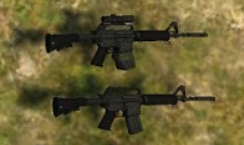
Shortened variant of the M16 rifle, with 11.5 inch barrel and equipped with a unique flash suppressor as a request by MACVSOG as a method to confuse the Viet Cong and NVA, as the moderator makes the weapon sound more like the AK and AKM rifles in use by the Viet Cong and NVA. This device reduces flash signature somewhat and alters the weapons sound signature, making the normally louder short barreled carbine sound like a AK/ AKM. While permitting a more compact and wieldy rifle, it suffered from lower reliability and worse ballistics. It was outphased after the Vietnam war, replaced by the Colt Model 653 carbines, and subsequently 723 and 727 carbines within late 1980s-early 1990s.
Notes: - Carbine/short barrel variants of the M16 were universally called as the "CAR-15" up until the adoption of the Colt Model 920 and 921, which later designated as M4 and M4A1 carbine, and the MK18 for 10-11 inch type barrels.
- Of today's popular terminology, 14.5 inch barrel ARs would be considered as carbine, whereas 10-11 inch barrel ARs would be considered as SBR (Short Barrel Rifle)
- Check out this video by Vickers Tactical for more info about Delta Force CAR-15/Model 723 setup
M203
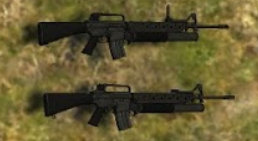
Underbarrel 40x46mm grenade launcher capable of being mounted to rifles, replacing the M79 grenade launchers in the US military (although M79s were still in use in case they needed a standalone grenade launcher which is more accurate than an underbarrel). Common ammo types are HE, HEDP (capable of penetrating 50mm of steel), and smoke rounds. HEDP was getting more and more common and had largely replaced HE as the standard among US forces later.
Soviet Armed Force's Arsenal
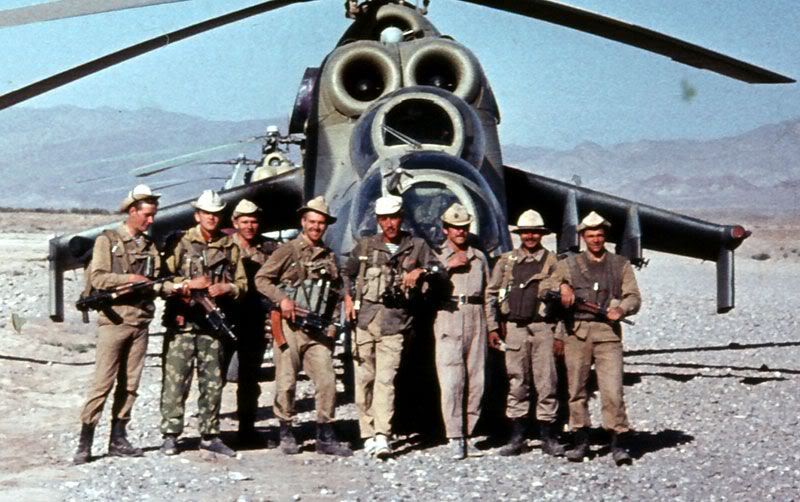
AK-74

Soviet advisors had seen the effectiveness of M16 rifles and small high velocity intermediate cartridges in Vietnam. The 5.56x45 M193 was found to produce nasty exit wounds as well. They concluded that they wanted to have their own equivalent to the American 5.56, as it was considered more advantageous, and while Mikhail Kalashnikov himself thought 7.62x39 was the better cartridge, he went on to create the AK in a new small intermediate cartridge. Thus the AK-74 and 5.45x39 cartridge was born, which became the primary service rifle of Soviet Union from 1974 until its breakup, where the AK-74 still remained as the staple service rifle of many Eastern European countries, with Russia having the modernized version of the AK-74M.
Notes: - Steel magazines were more expensive to manufacture, and by the time Soviets had adopted the AK-74, they also switched to making bakelite magazines for both 5.45 and 7.62x39 magazines, which had replaced steel magazines in production.
- The "bakelite" magazine is actually not bakelite. It is glass reinforced polyethylene. "Bakelite" is moreso a nickname due to its color. Bakelite magazines are lighter than steel magazines, yet less durable, but it is durable enough for rough use as long you don't intentionally try to break them.
- Soviet-made variants with dovetail rails for mounting Warsaw pact night vision scopes are designated with the "N" alphabet. e.g: AK-74N
- Folding stock variant is the AKS-74, a carbine variant is the AKS-74U which has different gas block, rifling, and higher rate of fire
AKM

The legendary invention of Mikhail Kalashnikov that had shaped the world. The AK-47 had went into numerous alterations until the AKM, which was the most numerous and standard variant of the 7.62x39 pattern AKs in use by Soviet Union until their adoption of the AK-74. Even after the AK-74 had replaced the AKM as the service rifle, the AKM still remained in use by rear echelon personnel. The AKM can be seen in the hands of many militaries, insurgents, rebel, militia, freedom fighters alike worldwide.
Notes: - China accounts as the largest producer of AK family rifles, Norinco Type 56s can be found in many corners of the world
- There is a folding stock variant which is the AKMS, and short barrel variant which is the AKMSU. Soviet-made variants with dovetail rails for mounting Warsaw pact night vision scopes are designated with the "N" alphabet. e.g: AKMN, AKMSN
- Contary to popular belief, 7.62x39 does not do more "damage" than either 5.56x45 nor 5.45x39. It has better barrier penetration and retaining energy post-penetration, but inferior wounding capability and body armor defeating capability.
- AKs are not inaccurate. If you actually know how to shoot, it will be sufficient.
- You will jam AKs if you drown them in mud. Your "Stalin-blessed" AK will still jam. Norinco Type 56 AKs that had happened to have poor quality build will most likely jam more than a Colt manufactured M16. Fuck this myth as well. Deal with it.
- AK selector is not hard to manipulate, and getting it into full auto is actually trickier than getting it into semi. Just need to get used to it. Just like how throwing the selector 180 degree to go full auto with M16/M4 is actually tricky.
- Different gun, different design, different tolerances, different pros and cons. I'm biased to liking the AR more since I'm more familiar with them, but AKs are my second favorite rifle family
RPK
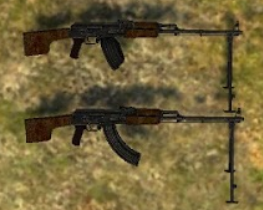
Replacing the RPD, the RPK was selected as the squad automatic weapon of the Soviet armed forces. Having the benefits of identical familiarity and functions to the AK-47/AKM, it is fit with longer and heavier barrel, new front sight base, folding bipod, etc, turning it into a lightweight, accurate, squad automatic firepower which also has the benefits of similarity and interchangibility of magazines with the standard service rifle. RPK automatic riflemen were either issued 40-round casket magazines or 75-round drum magazines, with drum magazines being rarer and less popular due to their bulk and less reliability.
RPK-74
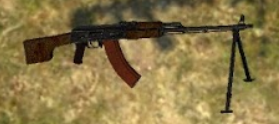
Rugged, robust, and accurate just like its predecessor albeit chambered for the 5.45x39. It was essentially an AK-74 with heavier and longer barrel, different stock, and other features that allowed it to be an effective squad automatic weapon that shares the similar ergonomics, familiarity, magazine compatibility as the standard service rifle. RPK-74 automatic riflemen are issued with 45-round bakelite magazines, but can use 30-round magazines if they need to (and vice versa with AK-74s)
PKM
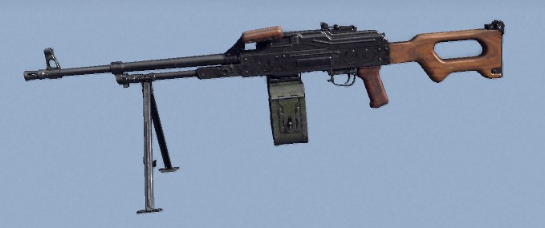
The PK series machine gun is the standard issue GPMG of Soviet armed forces and Warsaw Pact countries. The PK and later the PKM replaced the RP-46 and SGM machine guns in service, being a rugged, robust, reliable, accurate, yet lightweight design compared to other GPMGs of the time (M60, M240). It is a very well-made weapon, highly popular, and still continues to see service in many conclits up to this day.
Notes: - a PKM weights 7.5 kg unloaded, compared to M240, MG3, M60 and such that weight 10-13 kg unloaded... big difference right there. That's also why the PKM is so good!
SVD

Sniper Rifle, System of Dragunov, Model of the Year 1963, or better known as Dragunov SVD is a semi-automatic sniper rifle/DMR chambered in 7.62x54R. The SVD differs from the Mosin-Nagant bolt action in that it uses a gas-operated mechanism for semi automatic fire. Its 10-round magazine capacity is twice that of the Mosin-Nagant, and its accuracy surpasses that of the NATO standard. This, coupled with its repeat-fire capability provides sustained suppressing power against the enemy. It resembles the AK in appearance, but with its unique design is not a derivation. In fact, it uses short-stroke gas piston as opposed to long-stroke used within the AK. While certainly many modern DMRs/semi auto sniper rifles are more ergonomic and accurate than the SVD today, the SVD is still undoubtly a potent precision rifle that still stacks up to the game.
Notes: - The Dragunov SVD and 7N1 7.62x54R match ammunition were made with tight quality control and high standards. Shooting the 7.62x54R LPS light ball, it has roughly 2.2 MOA. With the 7N1 sniper cartridge, its accuracy goes up to roughly 1.24 MOA. Comparable accuracy to the M21... albeit with actually quality match ammunition, lighter, and much better reliability.
- Standard optic is the PSO-1 4x32 telescopic sight, The PSO-1 was, at the time of its introduction on 3 July 1963 together with the SVD, was probably the most technically advanced telescopic sight ever designed for a mass-production designated marksman or sniper rifle.
GP-25

Developed under research project "Kostyor", underbarrel grenade launcher attachment for AK pattern rifles firing 40mm caseless grenade rounds, in either HE or smoke.
#UPDATE: Weapon Behavior/Performance
To explain further on how our weapon systems work, we have their performance based on their real life practical characteristics, handling, and accuracy under the doctrine or manual commonly practiced for the weapon of the period. In our coding, we use our own brand new categorization and behavioral patterns. Vanilla setup/coding and ammo WILL NOT WORK and cause crash. So if you plan to make addons or use any of our codes/assets, keep that in mind.
The available categories for the behavior/patterns of the weapons by our mod coding are:
- Assault Rifles: Utilizing SMG weapon skill, firearms in this category fire intermediate cartridges and have more recoil, worse full auto controllability (thus single or burst fire is recommended in direct control. The AI automatically does 2-3 round bursts at range) and better range and accuracy than SMGs. There are several sub variants of the weapon such as Recce Rifles, SBRs, PDWs, and Carbine variants along with different accuracy levels based on ergonomics and weapon quality and optics
- SMGs: Utilizing SMG weapon skill, firing pistol cartridge and is limited in range and accuracy over longer distances compared to assault rifles. Have good accuracy over short distances and less recoil, making them more suited to CQB automatic suppression.
- Battle Rifles: Utilizing Rifle weapon skill, firing full power rifle cartridges, sub variants include different accuracy levels, optics, bolt or semi auto, etc. Against assault rifles, focus on being defensive and fight at more extended distances to increase advantages. Don't expect having more volume of fire.
- LMGs: Utilizing either Rifle or Mgun_light weapon skill depending on the nature of the weapon, troops equipped with these weapons use rifle animations but have their own distinctive performance that bridge the gap between rifles and GPMGs. While having less static firepower than GPMGs, these weapons provide better portable firepower, more maneuverable, better accuracy while standing and crouching, and weapons like the RPK have similar functions to the AK that riflemen and non-automatic riflemen can use it without a skill penalty. Such examples for the category are M249, RPK, BAR, Ultimax, L86 LSW, etc (no, Bren, Type 96, ZB-26 go to the GPMG category instead. While considered light machine guns by the standard of their era, they are still not as portable nor similar in nature to the weapons of this category)
- GPMGs: Utilizing mgun skill, machine guns firing full power rifle cartridges and are heavy weapons that they have a lot of weight for the user to carry and stamina will be drained even faster. Typically utilized with a designated machine gunner accompanied with assistant gunner that carries extra ammo with the same mgun skill level. This type of weapon will have poor accuracy while standing and crouching, thus deploy the weapon on cover and prone.
- HMGs: Utilizing mgun skill, machine guns chambered in .50 caliber type cartridges and anti-material and light vehicle purposes as well. M2HB, NSVT, KPVT, you name it
- Handguns: Utilizing pistol skill, these sidearms are meant to be backup weapons. Don't expect much performance out of this weapon. Get a shouldered firearm if you can. Handguns are much harder to use effectively and have limited range, accuracy, and effectiveness in real life, and that also applies in this mod. Sub category includes machine pistols, such as Stechkin APS and full auto Mauser C96s.
- Rocket Launchers: Utilizing rocketlauncher skill. Anti-tank or anti-personnel launchers. Their range and accuracy is dependent on their type of projectile and the nature of the weapon itself.
- Grenade Launchers: Utilizing rifle skill (for now), this includes from underbarrel to standalone grenade launchers as well as muzzle launched rifle grenades.
- Shotguns: Utilizing rifle skill (for now), shotguns are... shotguns. Bear in mind since we do not follow Hollywood logic, shotguns behave closer to real life and thus their range and accuracy are greater than what the popular media portrays. Different barrel lengths different accuracy. Coding accomodates most kind of shotguns, from pump to automatic to double barrel. 00 Buckshot, #4 Buckshot, and Slug shells are available.
Most importantly, just remember that weapons in Project 80 have their performance and behavior meticulously detailed and matched to their practical performance in real life, as well as their reliability and jam frequents. There is a lot of features and additional stuff that are previously not existing in MoW, but now they exist and they play their roles in determing the performanxe of the weapon. Forget about Hollywood and typical game balancing, just use your common sense and realistic logic. We give close to zero shit about "balance". Be sure to care about the little things because yes, they matter. An M16 does not have copy/paste stat of other assault rifles and a lot of guns have their own stats. Gun Jesus be praised \o/
We intend our mod to also be a technical reminder and education on how things would work (to the limits of game design and abstractly of course) as well as a rememberance on their history. Thus, you may ask questions regarding them, whether real life or mod-related, and our dev team may answer to their extend of knowledge (and our patience as well...)
If there is anything you have been wondering off about regarding the mod, feel free to shoot us a question. Until next time.



Looking good